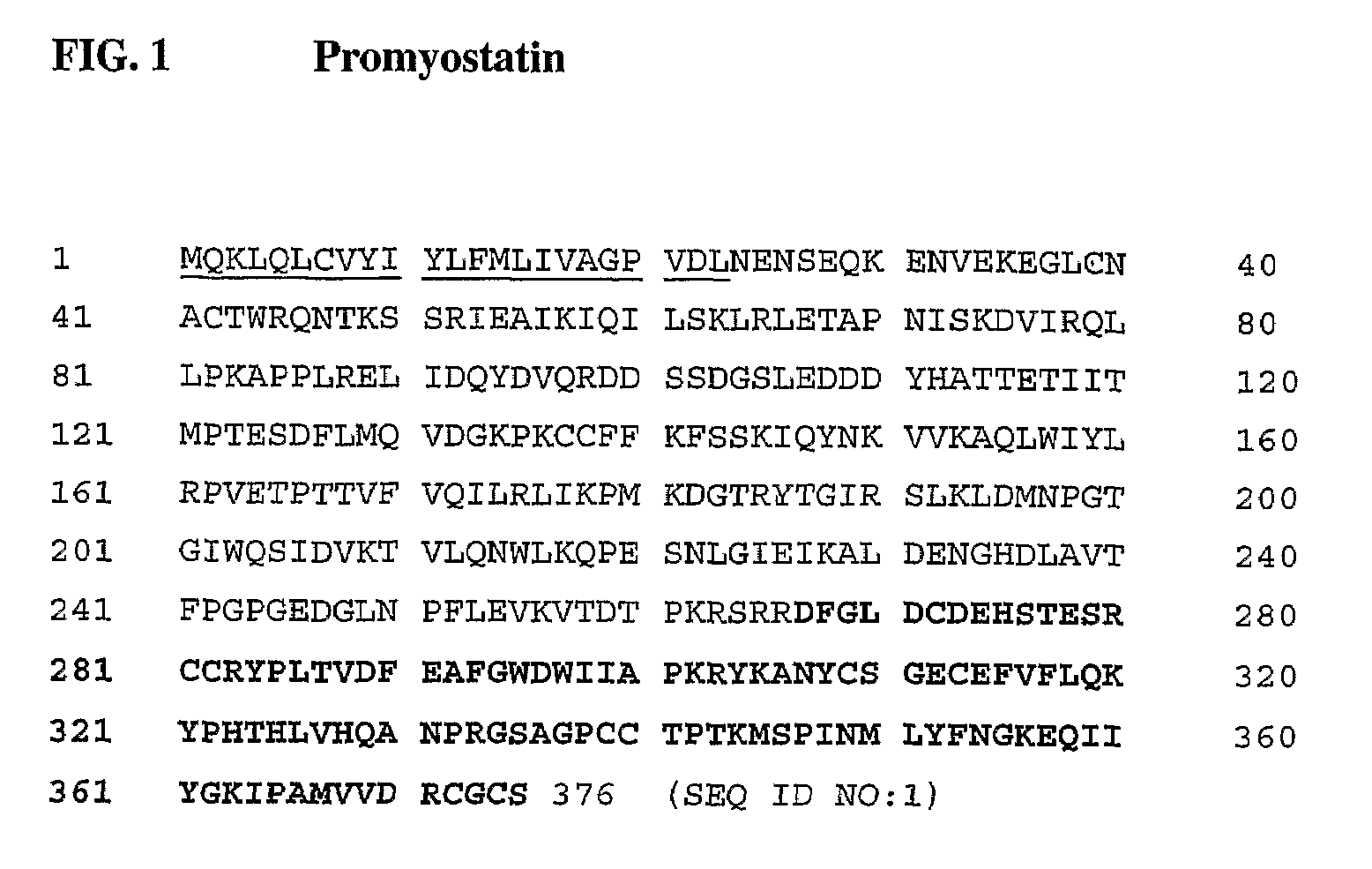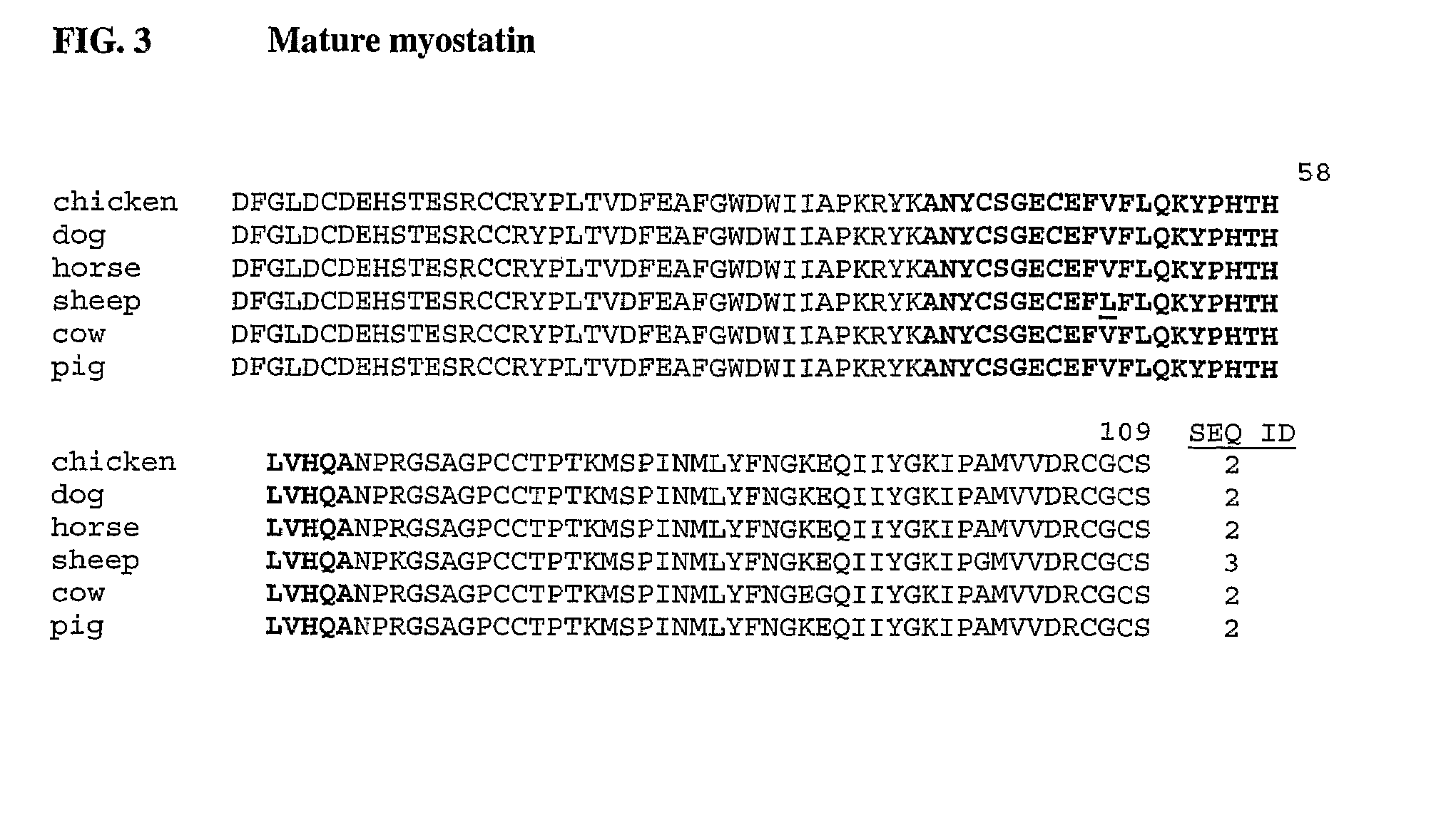Anti-myostatin antibodies
a technology of myostatin and antibodies, applied in the field of medicine, can solve the problems of limited treatment options for muscle wasting, and achieve the effects of enhancing muscle mass, and reducing the level of myostatin
- Summary
- Abstract
- Description
- Claims
- Application Information
AI Technical Summary
Benefits of technology
Problems solved by technology
Method used
Image
Examples
example 1
ELISA Assays
[0138]A. Anti-Myostatin Fabs Preferentially Bind Myostatin Over GDF-11.
[0139]Anti-myostatin Fabs (or full-length mAbs) of the present invention are tested in an ELISA assay, in which binding of the Fab to mature myostatin (dimeric form) coated at various concentrations on a 96-well plate is measured. Binding of the Fabs to GDF-11 is also tested.
[0140]Each well of two 96-well plates is coated with 200 ng / well recombinant mouse myostatin (R&D systems, Cat. #788-G8 / CF, carrier-free, in carbonate buffer, pH 9.6) or 200 ng / well recombinant human GDF-11 (Peprotech, Inc., Cat. #120-11, carrier-free, in carbonate buffer, pH 9.6). The plates are incubated at 4° C. overnight. The wells are aspirated and washed twice with washing buffer (20 mM Tris (hydroxymethyl) aminomethane, pH 7.4, 0.15 M NaCl, 0.1% Tween-20). The plates are blocked with 200 μl blocking buffer per well (5% Carnation Instant milk in the above washing buffer) for 5 hours.
[0141]Fabs or mabs to be tested are dilute...
example 3
Myostatin Neutralization Assay
[0157]Ectodermal explants are removed from stage 8-9 blastula Xenopus embryos by standard procedures and cultured in 0.5×MBS (1×MBS: 88 mM NaCl, 1 mM KCl, 0.7 mM CaCl2, 1 mM MgSO4, 5 mM HEPES, 2.5 mM NaHCO3, 1:1000 v / v gentamycin, 0.1% bovine serum albumin) with the addition of growth factor (GDF8 or GDF11) plus or indicated, for 18 hours at 18° C., by which time control embryos reach the early neurula stage (stage 15-16). Explants are photographed and the length of each explant is measured using an image analysis algorithm designed for animal cap quantitation. Explants not treated with either growth factor or Fab (controls), round into balls of epidermis. Myostatin and GDF-11 induce mesoderm in these ectodermal explants which causes the explants to elongate and form dumbbell-like structures. Antibodies or Fabs, when tested for neutralizing activity, are added to the culture medium containing myostatin for the entire length of the culture period and the...
example 4
Affinity Measurement of Fabs
[0159]The affinity (KD) and kon and koff rates of anti-myostatin Fabs of the present invention are measured using a BIAcore® 2000 instrument containing a CM4 sensor chip. The BIAcore® utilizes the optical properties of surface plasmon resonance to detect alterations in protein concentration of interacting molecules within a dextran biosensor matrix. Except where noted, all reagents and materials are purchased from BIAcore® AB (Upsala, Sweden). All measurements are performed at 25° C. Samples containing Fabs are dissolved in HBS-EP buffer (150 mM sodium chloride, 3 mM EDTA, 0.05% (w / v) surfactant P-20, and 10 mM HEPES, pH 7.4). Myostatin or GDF-11 (R&D Systems) is immobilized onto flow cells of a CM4 chip using amine-coupling chemistry. Flow cells (1-4) are activated with a 1:1 mixture of 0.1 M N-hydroxysuccinimide and 0.1 M 3-(N,N-dimethylamino)propyl-N-ethylcarbodiimide at a flow rate of 20 μl / min. Myostatin or GDF-11 (2.5 μg / mL in 10 nM sodium acetate, ...
PUM
| Property | Measurement | Unit |
|---|---|---|
| concentration | aaaaa | aaaaa |
| volume | aaaaa | aaaaa |
| pH | aaaaa | aaaaa |
Abstract
Description
Claims
Application Information
 Login to View More
Login to View More - R&D
- Intellectual Property
- Life Sciences
- Materials
- Tech Scout
- Unparalleled Data Quality
- Higher Quality Content
- 60% Fewer Hallucinations
Browse by: Latest US Patents, China's latest patents, Technical Efficacy Thesaurus, Application Domain, Technology Topic, Popular Technical Reports.
© 2025 PatSnap. All rights reserved.Legal|Privacy policy|Modern Slavery Act Transparency Statement|Sitemap|About US| Contact US: help@patsnap.com



